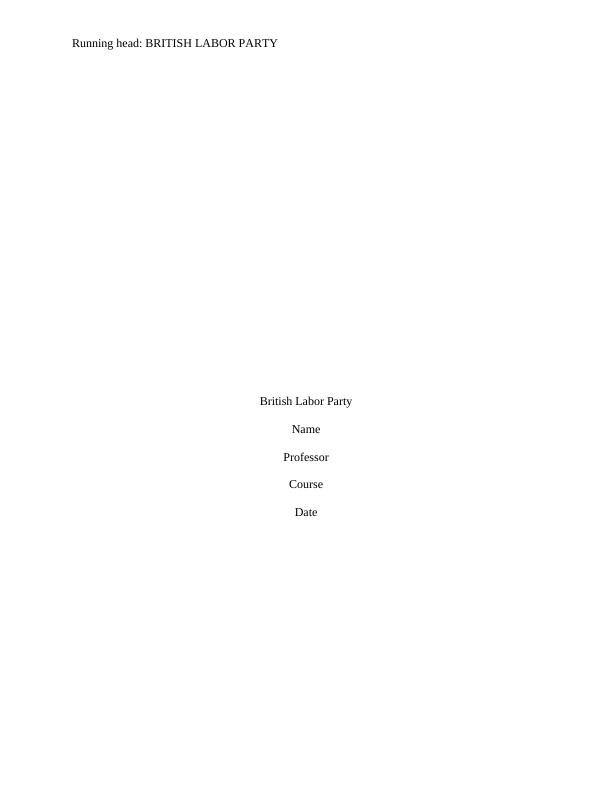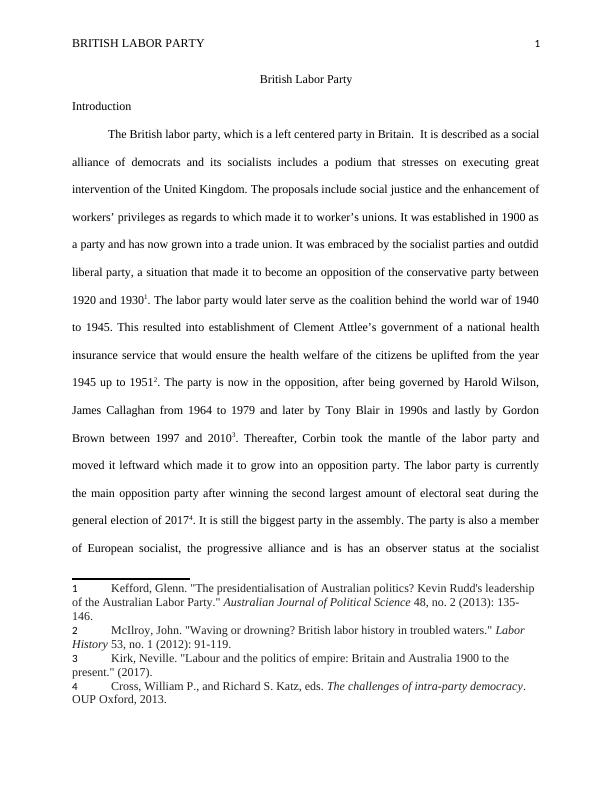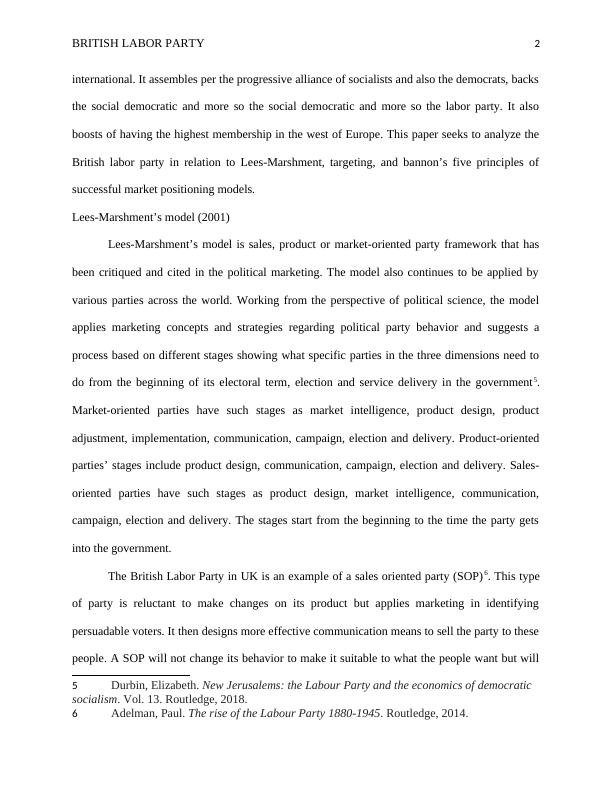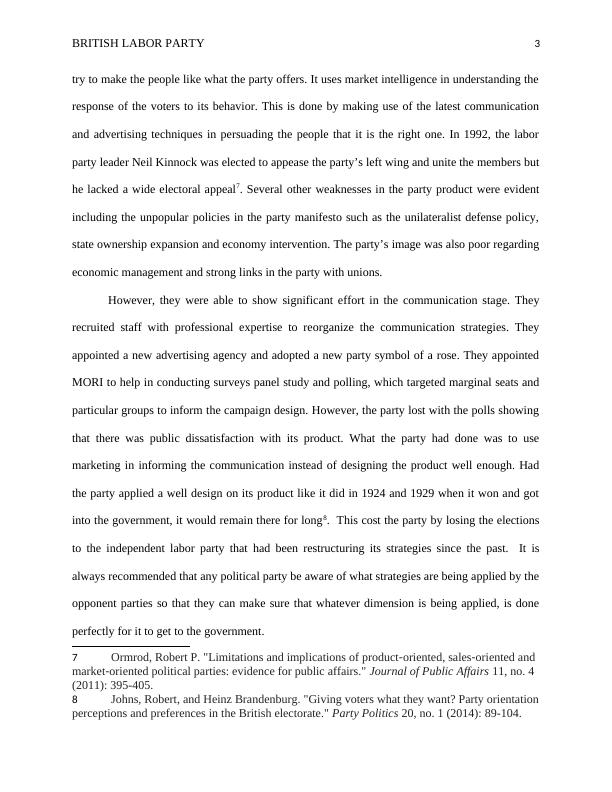British Labor Party
Added on 2023-04-21
15 Pages4991 Words387 Views
Running head: BRITISH LABOR PARTY
British Labor Party
Name
Professor
Course
Date
British Labor Party
Name
Professor
Course
Date

BRITISH LABOR PARTY 1
British Labor Party
Introduction
The British labor party, which is a left centered party in Britain. It is described as a social
alliance of democrats and its socialists includes a podium that stresses on executing great
intervention of the United Kingdom. The proposals include social justice and the enhancement of
workers’ privileges as regards to which made it to worker’s unions. It was established in 1900 as
a party and has now grown into a trade union. It was embraced by the socialist parties and outdid
liberal party, a situation that made it to become an opposition of the conservative party between
1920 and 19301. The labor party would later serve as the coalition behind the world war of 1940
to 1945. This resulted into establishment of Clement Attlee’s government of a national health
insurance service that would ensure the health welfare of the citizens be uplifted from the year
1945 up to 19512. The party is now in the opposition, after being governed by Harold Wilson,
James Callaghan from 1964 to 1979 and later by Tony Blair in 1990s and lastly by Gordon
Brown between 1997 and 20103. Thereafter, Corbin took the mantle of the labor party and
moved it leftward which made it to grow into an opposition party. The labor party is currently
the main opposition party after winning the second largest amount of electoral seat during the
general election of 20174. It is still the biggest party in the assembly. The party is also a member
of European socialist, the progressive alliance and is has an observer status at the socialist
1 Kefford, Glenn. "The presidentialisation of Australian politics? Kevin Rudd's leadership
of the Australian Labor Party." Australian Journal of Political Science 48, no. 2 (2013): 135-
146.
2 McIlroy, John. "Waving or drowning? British labor history in troubled waters." Labor
History 53, no. 1 (2012): 91-119.
3 Kirk, Neville. "Labour and the politics of empire: Britain and Australia 1900 to the
present." (2017).
4 Cross, William P., and Richard S. Katz, eds. The challenges of intra-party democracy.
OUP Oxford, 2013.
British Labor Party
Introduction
The British labor party, which is a left centered party in Britain. It is described as a social
alliance of democrats and its socialists includes a podium that stresses on executing great
intervention of the United Kingdom. The proposals include social justice and the enhancement of
workers’ privileges as regards to which made it to worker’s unions. It was established in 1900 as
a party and has now grown into a trade union. It was embraced by the socialist parties and outdid
liberal party, a situation that made it to become an opposition of the conservative party between
1920 and 19301. The labor party would later serve as the coalition behind the world war of 1940
to 1945. This resulted into establishment of Clement Attlee’s government of a national health
insurance service that would ensure the health welfare of the citizens be uplifted from the year
1945 up to 19512. The party is now in the opposition, after being governed by Harold Wilson,
James Callaghan from 1964 to 1979 and later by Tony Blair in 1990s and lastly by Gordon
Brown between 1997 and 20103. Thereafter, Corbin took the mantle of the labor party and
moved it leftward which made it to grow into an opposition party. The labor party is currently
the main opposition party after winning the second largest amount of electoral seat during the
general election of 20174. It is still the biggest party in the assembly. The party is also a member
of European socialist, the progressive alliance and is has an observer status at the socialist
1 Kefford, Glenn. "The presidentialisation of Australian politics? Kevin Rudd's leadership
of the Australian Labor Party." Australian Journal of Political Science 48, no. 2 (2013): 135-
146.
2 McIlroy, John. "Waving or drowning? British labor history in troubled waters." Labor
History 53, no. 1 (2012): 91-119.
3 Kirk, Neville. "Labour and the politics of empire: Britain and Australia 1900 to the
present." (2017).
4 Cross, William P., and Richard S. Katz, eds. The challenges of intra-party democracy.
OUP Oxford, 2013.

BRITISH LABOR PARTY 2
international. It assembles per the progressive alliance of socialists and also the democrats, backs
the social democratic and more so the social democratic and more so the labor party. It also
boosts of having the highest membership in the west of Europe. This paper seeks to analyze the
British labor party in relation to Lees-Marshment, targeting, and bannon’s five principles of
successful market positioning models.
Lees-Marshment’s model (2001)
Lees-Marshment’s model is sales, product or market-oriented party framework that has
been critiqued and cited in the political marketing. The model also continues to be applied by
various parties across the world. Working from the perspective of political science, the model
applies marketing concepts and strategies regarding political party behavior and suggests a
process based on different stages showing what specific parties in the three dimensions need to
do from the beginning of its electoral term, election and service delivery in the government5.
Market-oriented parties have such stages as market intelligence, product design, product
adjustment, implementation, communication, campaign, election and delivery. Product-oriented
parties’ stages include product design, communication, campaign, election and delivery. Sales-
oriented parties have such stages as product design, market intelligence, communication,
campaign, election and delivery. The stages start from the beginning to the time the party gets
into the government.
The British Labor Party in UK is an example of a sales oriented party (SOP)6. This type
of party is reluctant to make changes on its product but applies marketing in identifying
persuadable voters. It then designs more effective communication means to sell the party to these
people. A SOP will not change its behavior to make it suitable to what the people want but will
5 Durbin, Elizabeth. New Jerusalems: the Labour Party and the economics of democratic
socialism. Vol. 13. Routledge, 2018.
6 Adelman, Paul. The rise of the Labour Party 1880-1945. Routledge, 2014.
international. It assembles per the progressive alliance of socialists and also the democrats, backs
the social democratic and more so the social democratic and more so the labor party. It also
boosts of having the highest membership in the west of Europe. This paper seeks to analyze the
British labor party in relation to Lees-Marshment, targeting, and bannon’s five principles of
successful market positioning models.
Lees-Marshment’s model (2001)
Lees-Marshment’s model is sales, product or market-oriented party framework that has
been critiqued and cited in the political marketing. The model also continues to be applied by
various parties across the world. Working from the perspective of political science, the model
applies marketing concepts and strategies regarding political party behavior and suggests a
process based on different stages showing what specific parties in the three dimensions need to
do from the beginning of its electoral term, election and service delivery in the government5.
Market-oriented parties have such stages as market intelligence, product design, product
adjustment, implementation, communication, campaign, election and delivery. Product-oriented
parties’ stages include product design, communication, campaign, election and delivery. Sales-
oriented parties have such stages as product design, market intelligence, communication,
campaign, election and delivery. The stages start from the beginning to the time the party gets
into the government.
The British Labor Party in UK is an example of a sales oriented party (SOP)6. This type
of party is reluctant to make changes on its product but applies marketing in identifying
persuadable voters. It then designs more effective communication means to sell the party to these
people. A SOP will not change its behavior to make it suitable to what the people want but will
5 Durbin, Elizabeth. New Jerusalems: the Labour Party and the economics of democratic
socialism. Vol. 13. Routledge, 2018.
6 Adelman, Paul. The rise of the Labour Party 1880-1945. Routledge, 2014.

BRITISH LABOR PARTY 3
try to make the people like what the party offers. It uses market intelligence in understanding the
response of the voters to its behavior. This is done by making use of the latest communication
and advertising techniques in persuading the people that it is the right one. In 1992, the labor
party leader Neil Kinnock was elected to appease the party’s left wing and unite the members but
he lacked a wide electoral appeal7. Several other weaknesses in the party product were evident
including the unpopular policies in the party manifesto such as the unilateralist defense policy,
state ownership expansion and economy intervention. The party’s image was also poor regarding
economic management and strong links in the party with unions.
However, they were able to show significant effort in the communication stage. They
recruited staff with professional expertise to reorganize the communication strategies. They
appointed a new advertising agency and adopted a new party symbol of a rose. They appointed
MORI to help in conducting surveys panel study and polling, which targeted marginal seats and
particular groups to inform the campaign design. However, the party lost with the polls showing
that there was public dissatisfaction with its product. What the party had done was to use
marketing in informing the communication instead of designing the product well enough. Had
the party applied a well design on its product like it did in 1924 and 1929 when it won and got
into the government, it would remain there for long8. This cost the party by losing the elections
to the independent labor party that had been restructuring its strategies since the past. It is
always recommended that any political party be aware of what strategies are being applied by the
opponent parties so that they can make sure that whatever dimension is being applied, is done
perfectly for it to get to the government.
7 Ormrod, Robert P. "Limitations and implications of product‐oriented, sales‐oriented and
market‐oriented political parties: evidence for public affairs." Journal of Public Affairs 11, no. 4
(2011): 395-405.
8 Johns, Robert, and Heinz Brandenburg. "Giving voters what they want? Party orientation
perceptions and preferences in the British electorate." Party Politics 20, no. 1 (2014): 89-104.
try to make the people like what the party offers. It uses market intelligence in understanding the
response of the voters to its behavior. This is done by making use of the latest communication
and advertising techniques in persuading the people that it is the right one. In 1992, the labor
party leader Neil Kinnock was elected to appease the party’s left wing and unite the members but
he lacked a wide electoral appeal7. Several other weaknesses in the party product were evident
including the unpopular policies in the party manifesto such as the unilateralist defense policy,
state ownership expansion and economy intervention. The party’s image was also poor regarding
economic management and strong links in the party with unions.
However, they were able to show significant effort in the communication stage. They
recruited staff with professional expertise to reorganize the communication strategies. They
appointed a new advertising agency and adopted a new party symbol of a rose. They appointed
MORI to help in conducting surveys panel study and polling, which targeted marginal seats and
particular groups to inform the campaign design. However, the party lost with the polls showing
that there was public dissatisfaction with its product. What the party had done was to use
marketing in informing the communication instead of designing the product well enough. Had
the party applied a well design on its product like it did in 1924 and 1929 when it won and got
into the government, it would remain there for long8. This cost the party by losing the elections
to the independent labor party that had been restructuring its strategies since the past. It is
always recommended that any political party be aware of what strategies are being applied by the
opponent parties so that they can make sure that whatever dimension is being applied, is done
perfectly for it to get to the government.
7 Ormrod, Robert P. "Limitations and implications of product‐oriented, sales‐oriented and
market‐oriented political parties: evidence for public affairs." Journal of Public Affairs 11, no. 4
(2011): 395-405.
8 Johns, Robert, and Heinz Brandenburg. "Giving voters what they want? Party orientation
perceptions and preferences in the British electorate." Party Politics 20, no. 1 (2014): 89-104.

End of preview
Want to access all the pages? Upload your documents or become a member.